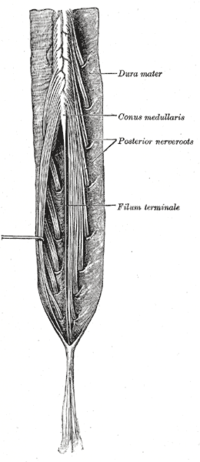
Photo from wikipedia
Objective Cauda equina syndrome (CES) is a potentially devastating spinal condition requiring prompt diagnosis and intervention. This study examines the relationship between timing of surgery and patient outcomes such as… Click to show full abstract
Objective Cauda equina syndrome (CES) is a potentially devastating spinal condition requiring prompt diagnosis and intervention. This study examines the relationship between timing of surgery and patient outcomes such as mortality and total complications, and longitudinal trends in timing of operative treatment over the years 2000–2014. Methods This study considered patients in the Healthcare Cost and Utilization Project National Inpatient Sample Database between 2000 and 2014 who had both an International Classification of Disease, Ninth Edition, Clinical Modification code for CES (344.61) and an International Classification of Disease, Ninth Edition, Clinical Modification procedure code for either disc excision (8051) or spinal canal exploration and decompression (0309) in their inpatient record. Patients were separated into an early surgical intervention cohort versus a delayed intervention cohort, and associated outcomes were analyzed using linear regression. Trends in timing of surgery were examined for the years 2000–2014, and linear regression was used to assess degree of change over time. Results In total, 20,924 patients with CES met inclusion criteria. Following adjustment for demographic variables, the delayed-intervention group was associated with statistically significant increased inpatient mortality (odds ratio [OR] 9.60, P = 0.002), total complications (OR 1.41, P = 0.018), and non-routine discharge (OR 2.37, P Conclusions This study represents the largest investigation to date examining CES and reveals the timing of surgical management for CES has not changed appreciably from 2000 to 2014 despite mounting evidence for early decompression. Patients receiving decompression within 0 or 1 day after admission are associated with improved inpatient outcomes, including lower complication and mortality rates.
Journal Title: World neurosurgery
Year Published: 2019
Link to full text (if available)
Share on Social Media: Sign Up to like & get
recommendations!